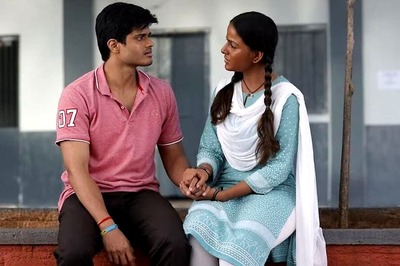
views
Different Types of Green Eyes
Light Green Light green eyes are on the paler side of the green-eyed spectrum. They have a soft green hue that’s similar to a jade stone or pale-colored olive. The “light” category of green eyes can also include more specific green eye shades, like bright green eyes or olive green eyes.
Dark Green Dark green eyes have a richer and more intense hue than light green eyes. Some dark green eyes appear emerald in color, while others take on a deeper forest green. These shades are mostly seen on people with naturally darker hair and skin tones, and some groups even believe that people with dark green eyes have a strong connection to the natural world.
Bright Green Bright green eyes are extremely vibrant and typically appear to be light in color. They stand out very obviously, and when you meet a person with bright green eyes, they’re probably the first thing that you’ll notice about them. These green-eyed individuals often have a very distinct contrast between their dark pupils and their striking green irises.
Olive Green As their name implies, olive green eyes have an olive-like hue that results from a mix of yellow and green pigments. This green eye shade is subtle and soft, and it’s particularly noted for changing appearance in different lighting.
Yellow Green Yellow-green eyes are a rare type of green eye that have a relatively high amount of yellow pigment mixed in. The resulting hue has a warm and golden appearance. This shade of green eye is another that tends to change depending on the lighting—the irises may alternate between looking more golden-yellow and more light-green.
Blue Green Blue-green eyes contain a unique blend of green and blue hues, almost giving off a turquoise or aquatic appearance. The addition of blue in the iris makes blue-green eyes even rarer than pure light or dark green eyes—which are fairly rare in their own right! Blue-green eyes are also distinct from hazel eyes; some hazel eyes are ringed with blue, but they’re always predominantly brown and green. Blue-green eyes, on the other hand, feature an equal mix of green and blue.
Gray Green Gray-green eyes feature an almost equal combination of green and gray hues. Depending on the lighting, they may look lighter or darker, but they almost always give off a mysterious or smokey vibe. Scientifically, the unique gray-green appearance results from a combination of low melanin in the iris and high collagen in the front layer of the iris. The light that reflects off of the collagen fibers appears like a “cloud” effect, contributing to the gray-green shade.
Hazel Green Hazel green eyes aren’t technically a type of “green” eye. Rather, hazel eyes are a shade distinct from green and brown, but they contain a blend of green, brown, gold, and sometimes blue pigments in the iris. Depending on the lighting or the clothing that a person is wearing, they may appear more green, brown, or gold. This “shape-shifting” quality is part of what makes hazel eyes so vibrant and captivating.
Green with Flecks Green eyes with flecks of brown or gold aren’t technically classified as green eyes—they’re officially hazel eyes. However, some people identify as having green eyes because their eyes are predominantly green with small specks of other colors, like gold, brown, gray, or yellow. These flecks can be caused by iris or eye freckles, or nevi (which are similar to freckles or moles on the skin). Speckles in the eye may also be caused by partial heterochromia, where varying levels of melanin pigment are unevenly distributed throughout the iris. This distribution results in a mix of colors, such as a green iris with golden or brown flecks.
Are green eyes rare?
Yes, green eyes are the rarest eye color in the world. Only about 2% of the world’s population has green eyes. The U.S. has a slightly higher proportion of green eyes, with 9% of the population having green eyes. Green eyes are considered to be most common in northern Europe, particularly in Germany and France, as well as Central Asia. Iceland has some of the highest incidences of green eyes among its citizens, with about 8-10% of men and 18-21% of women having green eyes. Amongst European Americans, green eyes are most common among those with Celtic and Germanic heritage, with 16% of that group having green eyes.
What causes green eyes?
Green eyes are determined by genetics. Specifically, the gene OCA2 regulates the production of melanin in a person’s body, and the level of melanin is a large part of what determines an individual’s eye color. People with green eyes have an intermediate level of melanin when compared to other eye shades—brown-eyed individuals have a higher melanin production, while blue-eyes individuals have a lower melanin production. Due to the low level of melanin in the front layer of a green eye’s iris, more light is able to enter and reflect back out of the eye, which is what gives it a lighter, greener shade. Another factor that contributes to green eyes is the genetics passed down to a person by their parents. For someone to have green eyes, they must inherit the green-eyed gene from both of their parents. The green-eyed gene is recessive to brown but dominant to blue, meaning that if one parent has green eyes (carrying one green-eyed gene) and the other has brown eyes (carrying one brown-eyed and one green-eyed gene), it’s most likely that their child will have brown eyes. However, if both parents do carry the green-eyed gene, it’s still possible that their child will inherit two green-eyed genes and end up with green eyes. Evolutionarily, green eyes are believed to have evolved as an adaptation to low light conditions in Northern Europe. The low amount of melanin in green eyes may make it easier to see in dim lighting.
Why do green eyes look different in different lighting?
Green eyes slightly change color based on how external light reflects off the iris. This effect is known as “Rayleigh scattering,” where light bounces off the iris and scatters, altering the appearance of the eye. In softer or dimmer lighting, green eyes may appear darker or richer in color. Conversely, green eyes may appear lighter and brighter in sunlight or bright lighting.
What do green eyes symbolize?
Green eyes may symbolize jealousy and a connection to nature. Green eyes (and people with green eyes) are often linked to nature, life, and fertility. This mystical connection to the Earth likely comes from the natural hue of green eyes, but it may also stem from the use of green eyes in folkloric and supernatural beliefs. Witches, fairies, and other spiritual creatures are often depicted with green eyes, contributing to the shade’s symbolic meaning. Green eyes may also be associated with jealousy due to the English idiom “green-eyed,” which means that someone is feeling envious of someone else. The phrase originates with William Shakespeare, as it appears in both Othello and The Merchant of Venice.
Fun Facts About Green Eyes
Green eyes do more than just look pretty! As the rarest eye color known to man, green eyes have a fascinating history full of interesting facts and biological phenomena. Here are just some of the many fun facts about green eyes and the people who have them: Green-eyed people are more sensitive to sunlight due to a lack of protective melanin. Green eyes are actually colorless. The low level of melanin affects the way light scatters out of the eyes, making them appear green. Green eyes often change color throughout the day, looking hazier in the morning and darker as the day progresses. Around two-thirds of the population of Liqian, China have green eyes. Females are more likely to have green eyes compared to males. Babies aren’t born with green eyes. The color develops 6-12 months after birth. Animals often have green eyes, including cats, chameleons, and cheetahs.
Famous People with Green Eyes
Green-eyed celebrities include Scarlett Johansson, Paul Rudd, and Fergie. While green is the rarest eye color, many popular celebrities boast a pair of the verdant-hued peppers. Here are some of the most well-known public figures who have green eyes: Elizabeth Olsen Emma Stone Maisie Williams Gigi Hadid Kate Middleton Joaquin Phoenix Tom Cruise Harry Styles Gary Dourdan Glen Powell
How to Enhance Green Eyes
Wear eye makeup with red undertones or gold and purple hues. Choose eyeshadows with reddish and purple tones, like shades of coral-orange, maroon, pinkish-red, mauve, violet, and eggplant. These colors will make the green in your eyes really pop and stand out. You can also enhance deep green tones in your eyes by using gold or bronze eyeshadow palettes. Apply the same colors to the rest of your eye makeup, such as berry-colored eyeliners and dark green mascaras. Makeup artist Devorah Kuperland recommends “playing with browns, purples, and greens. Shift your focus from black eyeliners to different colors, even if it’s a subtle hint like eyeliner inside the inner rim.” “Cool colors like blue, gray, and green” also bring out the green eye, adds master cosmetologist Shun Pittman. “You can also do a simple nude eye and accentuate your lashes to draw attention to the green eyes because green eyes are beautiful in and of themselves.”
How to Get Green Eyes
Use colored contacts to achieve the green-eyed look. If you don’t naturally have green eyes, you can fake it ‘til you make it with a pair of green-colored contacts. Colored contact lenses cover up your original iris color, changing your eye color to your chosen green hue. However, keep in mind that green contacts should only be worn for 10-12 hours a day, and it’s advised to buy prescription contacts in order to prevent damage to your eye.
Green Eyes FAQs
Are green eyes attractive? While attractiveness is subjective, many surveys conclude that green eyes are especially appealing due to their rarity and striking shade. For example, an online survey from AllAboutVision.com collected more than 66,000 responses, and 20.3% of respondents chose green eyes as the most attractive.
What are the chances of having green eyes? It’s difficult to determine any individual person’s probability of having green eyes. You’d have to factor in their genetic makeup as well as the genetic makeup of their parents and ancestors. For instance, someone with a family history of green eyes is more likely to have green eyes than someone who doesn’t. Overall, however, only 2% of the world’s population has green eyes.
What ethnicities have green eyes? All races and ethnicities can have green eyes. For example, Caucasian, African, Asian, Arabic, and Hispanic people can all have green eyes, among other ethnic and racial groups. However, green eyes are most common in Western and Northern Europe.




















Comments
0 comment